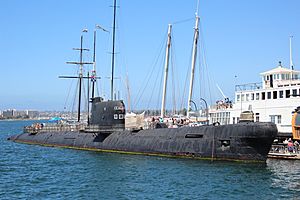Soviet submarine B-39 facts for kids

B-39, homeported in San Diego, California
|
|
Quick facts for kids History |
|
|---|---|
| Name | Б-39 |
| Builder | Admiralty Shipyard |
| Laid down | 9 February 1962 |
| Launched | 15 April 1967 |
| Commissioned | 28 December 1967 |
| Decommissioned | 1 April 1994 |
| Homeport | Vladivostok |
| Fate | Museum Ship, Maritime Museum of San Diego, San Diego, California, United States |
| General characteristics | |
| Class and type | Foxtrot-class submarine |
| Displacement |
|
| Length | 89.9 m (294 ft 11 in) |
| Beam | 7.4 m (24 ft 3 in) |
| Draft | 5.9 m (19 ft 4 in) |
| Propulsion |
|
| Speed |
|
| Range |
|
| Endurance | 3–5 days submerged |
| Test depth | 246–296 m (807–971 ft) |
| Complement | 12 officers, 10 warrants, 56 seamen |
| Armament |
|
The B-39 was a large diesel-electric attack submarine built for the Soviet Navy. It was part of a group of submarines known as Project 641, or the Foxtrot-class class. The "B" in its name stands for bolshaya, which means "large" in Russian. Foxtrot submarines were the biggest non-nuclear submarines the Soviet Navy had. Today, the B-39 is a museum ship that you can visit at the Maritime Museum of San Diego in California, United States.
Contents
Life as a Soviet Submarine
The building of the B-39 started on 9 February 1962 at the Admiralty Shipyard in Leningrad (now Saint Petersburg). It was launched into the water on 15 April 1967. The submarine officially joined the Soviet Navy on 28 December 1967.
Patrols and Missions
The B-39 became part of the 9th Submarine Squadron of the Soviet Pacific Fleet. Its home base was in Vladivostok, Russia. The submarine went on many patrols, secretly following U.S. warships. It traveled across the North Pacific Ocean, along the coasts of the United States and Canada. It even went as far as the Indian Ocean and the Arctic Ocean. After the Vietnam War ended, the B-39 often visited the port of Da Nang in Vietnam. In the early 1970s, the B-39 even followed a Canadian frigate (a type of warship) through the Strait of Juan de Fuca to Vancouver Island.
Close Encounter at Sea
In 1989, while in the Sea of Japan, the B-39 was on the surface charging its batteries. It came very close, about 500 yards (457 m), to a U.S. Navy frigate. Both crews were able to take pictures of each other during this unexpected meeting.
From Warship to Museum
The B-39 was taken out of service on 1 April 1994. After that, it was sold to Finland. From there, it was sold several more times. In 1996, it moved to Vancouver Island, and in 2002, it went to Seattle, Washington. Finally, on 22 April 2005, the B-39 arrived in San Diego, California. Here, it became a special exhibit at the Maritime Museum of San Diego. During its time with different owners, it was sometimes called "Black Widow" or "Cobra," but these were not its official names when it was in the navy.
A Look Through the Periscope
When the B-39 became a museum, a part of its attack periscope was changed. Normally, you can only look through the periscopes from the submarine's conning tower, which is a small, high part of the ship. However, in the museum, the conning tower is not open to visitors. So, a section around the periscope in the control room was cut away. This lets visitors look through the partially raised periscope. It points towards the USS Midway museum ship, which is about 500 yards (460 m) away. This change makes it seem like the periscope could be used from the control room, even though it couldn't originally.
Future of the Submarine
At one point, there was a plan to sink the B-39 to create an underwater diving spot. However, many teachers and submarine fans spoke up. They wanted to save the submarine, so for now, it will stay as a museum.
Movie Star Submarine
The B-39 has even been in movies and TV shows! In 2000, while it was stored in Vancouver, it was used for scenes in the TV show Stargate SG-1. You can see it in the episode called "Small Victories." In 2012, it was also used as a set for the movie Phantom.
Current Condition
The B-39 is quite old now and shows signs of wear. It has a lot of rust, and you can see large holes in its outer hull and upper deck. People are working to keep it floating for now. However, there are no plans to fix the big damage to its hull. Because of this, it is expected that the submarine will need to be sunk sometime in the future.
Fun Facts
To get inside the B-39, you need to be able to climb through a special obstacle. This is because the passages between the submarine's rooms are very tight. You can find this obstacle on the dock near the ramps that lead to the submarine's deck. It looks like a large cylinder and helps show you how small the doorways are inside the submarine.

